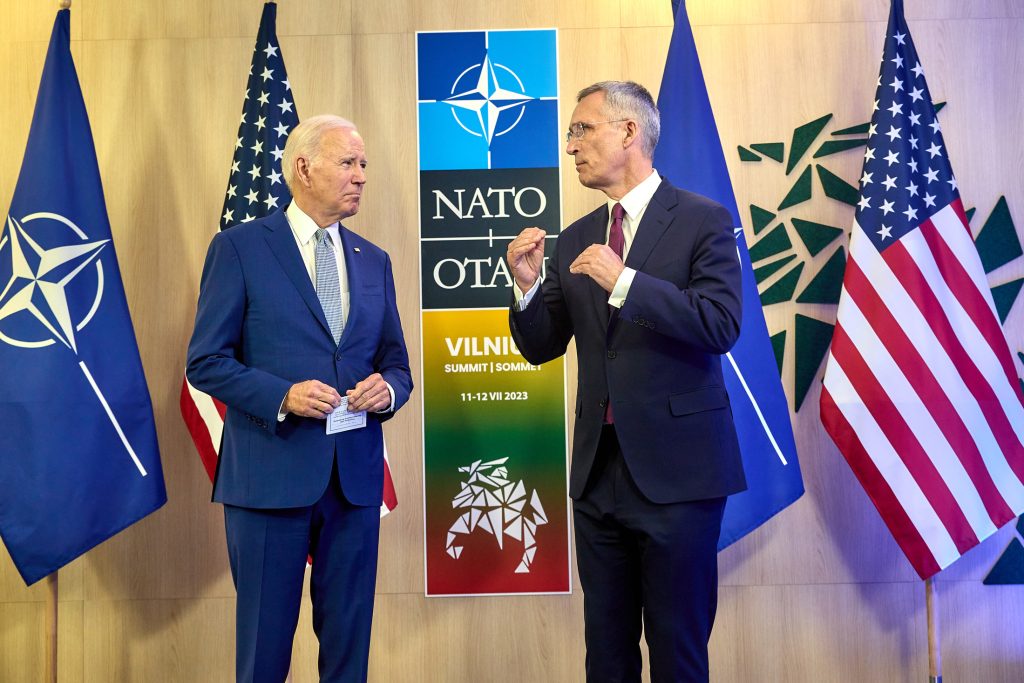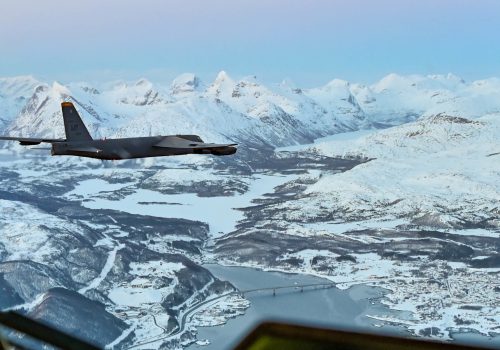While political tensions over Ukraine dominated the headlines, the NATO Summit in Vilnius also yielded an underreported opportunity for securing the Alliance’s stability and cohesion. The Defense Production Action Plan (the Plan), buried deep within the Vilnius summit communiqué, is an agreement by NATO member heads of state and government to cultivate a sustainable defense industrial capacity across the Alliance, with a focus on bolstering interoperability, standardizing materiel, and producing requisite levels of land munitions.
The Plan, although in its nascent stages, holds substantial promise. Its potential as a catalyst for unity within the Alliance is significant, with its scope and influence yet to be explored and realized. Drawing from my experience as the architect of both NATO’s Defense Innovation Accelerator for the North Atlantic (DIANA) and the NATO Innovation Fund, I know that the Plan’s successful implementation will require a collective commitment and astute navigation through the inevitable domestic industrial unease that many allies will experience. NATO allies must be laser focused on improving rapid defense acquisition, streamlining contract issuance, and creating a standards model fit for the twenty-first century.
Longstanding NATO programs such as the Airborne Warning and Control System (AWACS) and Alliance Ground Surveillance not only provide critical capabilities, they also foster a shared sense of ownership and joint commitment that binds the allies together. These programs involve extensive coordination and cooperation among member states, each contributing resources, personnel, and expertise to create a collective capability. The yet-to-be-implemented Plan, through shared projects and standards, holds the potential to further this sense of solidarity across the Alliance. Its focus on fostering a more effective allied industrial capacity, building resilience into the necessary stockpiles of munitions, and supporting a well-distributed network of defense companies across all Alliance members could be key in achieving these goals.
Defining what allies need for their defense begins with political guidance, which translates into requirements and then capability targets, all of which are derived through NATO’s defense planning process. These targets are then analyzed by the Defence Investment Division at NATO headquarters, with a particular focus on their practical implementation. However, navigating this process can be complex, especially as allies strive to protect their domestic industries from undue foreign competition. Moreover, the process of multinational acquisitions is notoriously slow and often riddled with political maneuvering, which poses challenges.
The evolution and adaptability of NATO will hinge on the Plan’s success in transitioning from theory to practice in our fast-paced global landscape.
In my previous roles, I saw firsthand the pivotal role that small and medium enterprises (SMEs) stand to offer. However, their potential can only be tapped through strategic alignment with initiatives like DIANA and the NATO Innovation Fund, which aim to foster innovation within the defense ecosystem of the Alliance and create flows of capital to support their timelines.
Expediting contract issuance is the central challenge of this initiative. While industry remains prepared and willing, the slow pace with which governments grant contracts is a major impediment. In response, NATO has three options at its disposal. The first entails bolstering contract issuance through the utilization of its Support and Procurement Agency or its Communications and Information Agency. The second involves the establishment of a comprehensive ecosystem that facilitates a more streamlined and coordinated contracting process among allies. This ecosystem would encompass the involvement of governments, defense contractors, SMEs, and innovation hubs like DIANA and the NATO Innovation Fund. Such an ecosystem would foster a collaborative environment aimed at improving efficiency in contracting procedures. The final option entails the amalgamation of these approaches, which takes into account the imperative of respecting national sovereignty while concurrently enhancing interoperability and standardization through multinational acquisition.
The Plan also seeks to enhance standards and interoperability. Traditionally, NATO has emphasized this subject, but the task has not been without its challenges. The current standards development process, spanning approximately thirty-six months, often results in broad compromises due to competing national interests, limiting interoperability and, ultimately, deterrence. The Plan could overcome these issues by involving companies more directly in the standards development process, shortening the time frame, and embracing civil, open standards for new and emerging technologies.
The Plan should also address the ongoing challenge of ensuring resilient supply chains across the Alliance. By coordinating the production of goods, NATO could achieve a more streamlined and secure supply network. This approach would not only enhance operational efficiency but also the collective resilience of the Alliance against potential disruptions. Moreover, this coordinated production could also stimulate mutual growth and technological advancement among Alliance members. However, successful implementation will require close collaboration between governments and industries, underlining the critical need for timely contract issuance.
NATO should implement the following additional steps to ensure the successful execution of the Defense Production Action Plan:
- Emphasize the resolution of the contracting issue by adopting dynamic sourcing or agile contracting. These methods enable a shift to issuing smaller, regular contracts to several companies, instead of larger ones to a few firms. This approach expedites the process, stimulates competition, and minimizes risks for allies by reducing financial and time commitments while continually assessing vendors’ performance.
- Partner with allies to modernize the existing export and International Traffic in Arms Regulations controls to accommodate the needs of multinational consortiums and the speed of goods being delivered to allies.
- Engage with the European Union (EU) by involving the European Innovation Council. This collaboration would help identify potential startups that can contribute to the initiative. Additionally, securing NATO representation at the US-EU Trade and Technology Council would help highlight pertinent issues. This might include arrangements that support the application of cutting-edge, additive manufacturing technologies, and forward locating production facilities to take advantage of these advancements. Additive manufacturing, or 3D printing, enables efficient production of complex parts, rapid prototyping, and localized, on-demand production, all of which can significantly enhance NATO’s responsiveness and resilience.
- Provide financial support to startups through interest-free bridge loans. Establishing an allied startup trust fund could facilitate the disbursement of these funds.
- Explore the possibility of making NATO standards legally binding, drawing insights from the EU’s practice.
As NATO approaches its seventy-fifth anniversary at the Washington Summit next year, rapid contract issuance by allied governments will be a significant measure of the Defense Production Action Plan’s progress. By adjusting their contracting practices to accommodate smaller, more frequent contracts, governments can invigorate the Plan’s potential to enhance interoperability, bolster supply networks, and distribute the industrial base across the Alliance more evenly.
Agile contracting and dynamic sourcing methods will be pivotal in accelerating contract issuance and diversifying defense suppliers. Steps toward a reformed standards development process that integrates industry input and addresses new technologies will also indicate promising progress.
Though the Defense Production Action Plan may not headline the Washington Summit, its role in fostering practical advancements in NATO’s defense infrastructure will remain crucial. The evolution and adaptability of NATO will hinge on the Plan’s success in transitioning from theory to practice in our fast-paced global landscape.
Rob Murray is a nonresident senior fellow in the Forward Defense program of the Atlantic Council’s Scowcroft Center for Strategy and Security.
Further reading
Thu, Jun 8, 2023
Operationalizing integrated deterrence: Applying joint force targeting across the competition continuum
Report By
General James E. Cartwright, Lieutenant Colonel Justin M. Conelli, Clementine G. Starling, and Julia Siegel advance a framework for operationalizing integrated deterrence.
Wed, Apr 12, 2023
Atlantic Council Commission on Defense Innovation Adoption interim report
Report By
The DoD must accelerate defense innovation adoption from the leading edge of the private sector. This report has ten recommendations to do so.
Thu, Jun 1, 2023
Autonomy and asymmetry: The future of Norway’s defense 2022-2042
Issue Brief By August Cole
August Cole provides an in-depth examination of Norway's potential defense strategies, the implications of autonomous drones and artificial intelligence, and the necessary transformation of military norms in response to the threats from Russia and beyond.
Image: Secretary General of NATO Jens Stoltenberg greets US President Joe Biden during the NATO Summit in Vilnius, Lithuania, on July 12, 2023.



